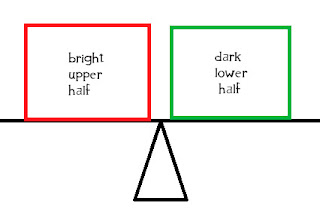Example 1
The balance here is fairly easy to see and is partly given by the shapes and partly by the contrast between light/dark. The eye is drawn diagonally across the image from bottom left to top right. The image is rather ‘top-heavy’ but it still makes for an interesting picture.
Example 2
 In this case the balance can be looked at from left to right as shown in this diagram and also as a vertical balance around the horizontal centre line. The vertical halves are evenly balanced while the horizontal halves are shifted to the right and the heavy weight of the buildings is contrasted by the curve of the bridge giving a degree of tension to the image.
In this case the balance can be looked at from left to right as shown in this diagram and also as a vertical balance around the horizontal centre line. The vertical halves are evenly balanced while the horizontal halves are shifted to the right and the heavy weight of the buildings is contrasted by the curve of the bridge giving a degree of tension to the image.Example 3
 There is a simple balance here between the dark lower half and the bright upper half, but here is also a more complex balance betwwn the V-shape of the bridge platform and the division in the water against the curve of the upper part of the bridge and the taut diagonal support lines
There is a simple balance here between the dark lower half and the bright upper half, but here is also a more complex balance betwwn the V-shape of the bridge platform and the division in the water against the curve of the upper part of the bridge and the taut diagonal support linesExample 4.
 The balance in this image is between the dark and heavy wight of the houses against the larger but lighter and brighter sky. Although the sizes of the two parts are very different they balance well because of the differing mass of the light and dark areas.
The balance in this image is between the dark and heavy wight of the houses against the larger but lighter and brighter sky. Although the sizes of the two parts are very different they balance well because of the differing mass of the light and dark areas.Example 5
 This is a very simple example of balance as all the weight of the picture is central and forms a V shape directing attention at the snowy boots.
This is a very simple example of balance as all the weight of the picture is central and forms a V shape directing attention at the snowy boots.





No comments:
Post a Comment